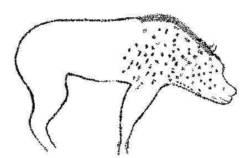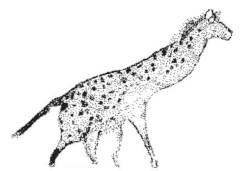Cave Hyena
Crocuta crocuta spelaea





The Cave Hyena (Crocuta crocuta spelaea) often used caves as its den, the hyena den. It is also called the Ice Age spotted hyena, as it is a paleosubspecies of spotted hyena, a subspecies which is now extinct and lived in Eurasia during the last ice age. They brought dead animals into the caves and ate them there. As a result bones of many animals can be found in such caves, even those which would never enter the cave on their own. Such bone caves were found from the Iberian Peninsula to eastern Siberia. As a result, the cave hyena is one of the best known mammals of the Ice Age.
Today hyenas live in Africa, no hyenas survived in Eurasia. Numerous species which were adapted to the cold age vanished at the end of the last cold age about 12,000 to 8,000 years ago. Some animal species followed the colder climate to Scandinavia, others became extinct. The reason for their extinction is obviously the climate change, or in many cases, the appearance of humankind, which either hunted the animals or destroyed their habitat. Increasing competitive pressure from humans may have deprived them of food or shelter.
Humans used the hyena, which was a part of their daily life, in art in caves.
We have two examples on this page, one from
 Grotte Chauvet
and one from
Grotte Chauvet
and one from
 Grotte de Lascaux.
The one from Lascaux seems drawn by someone who was not very good at it, the proportions are wrong, but there are several other details which make it a hyena, e.g. the dots.
Probably it shows a fantasy, some kind of hyena-man combination, or a shaman wearing hyena fur.
However, it shows that hyenas were quite important for our ancestors.
Grotte de Lascaux.
The one from Lascaux seems drawn by someone who was not very good at it, the proportions are wrong, but there are several other details which make it a hyena, e.g. the dots.
Probably it shows a fantasy, some kind of hyena-man combination, or a shaman wearing hyena fur.
However, it shows that hyenas were quite important for our ancestors.
Cave hyenas were trogloxenes, despite the name. They sought out the caves for shelter, used them primarily as feeding grounds and left behind characteristic feeding remains and coprolites. However, they were not adapted to this habitat. The remains found in Balver Höhle, Germany, show that cave hyenas, cave bears and humans took turns visiting the cave during the same periods. Neither actually lived in the cave, they used it only for a short time, if it was uninhabited.
Literature
- D. Nagel, N. Rohland, M. Hofreiter (2004): Phylogeography of the cave hyaena (Crocuta crocuta spelaea) – morphology versus genetics, 18th International Senckenberg Conference 2004 in Weimar, 2004.
- N. Rohland, J. L. Pollack, D. Nagel, C. Beauval, J. Airvaux, S. Pääbo, M. Hofreiter (2005): The Population History of Extant and Extinct Hyenas, In: Molecular Biology and Evolution. Vol 22, Nr. 12, 2005, pp 2435–2443. DOI pdf
- N. Spassov, T. Stoytchev (2004): The presence of cave hyaena (Crocuta crocuta spelaea) in the Upper Palaeolithic rock art of Europe, Historia naturalis bulgarica, 16: 159-166. academia.edu
 Search DuckDuckGo for "Cave Hyena"
Search DuckDuckGo for "Cave Hyena" Cave hyena - Wikipedia (visited: 10-APR-2021)
Cave hyena - Wikipedia (visited: 10-APR-2021) Cave Hyena (visited: 08-FEB-2024)
Cave Hyena (visited: 08-FEB-2024)
 Index
Index Topics
Topics Hierarchical
Hierarchical Countries
Countries Maps
Maps